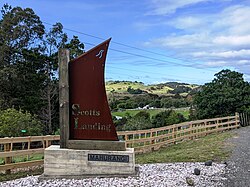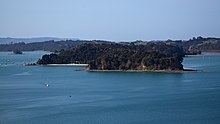Scotts Landing | |
|---|---|
 Scotts Landing sign | |
|
| |
| Coordinates: 36°29′06″S 174°43′30″E / 36.485°S 174.725°E | |
| Country | New Zealand |
| Region | Auckland Region |
| Ward | Rodney ward |
| Local board | Rodney Local Board |
| Electorates | |
| Government | |
| • Territorial Authority | Auckland Council |
| Area | |
| • Total | 2.56 km2 (0.99 sq mi) |
| Population (June 2023)
[2] | |
| • Total | 170 |
| • Density | 66/km2 (170/sq mi) |
Scotts Landing, also called Mahurangi East, is a rural settlement in the Auckland Region of New Zealand. It is at the end of a narrow peninsula on the eastern side of Mahurangi Harbour. Algies Bay is to the north. [3]
History
Casnell Island (Motu Maunganui), accessible from Scotts Landing at low tide via a causeway, was a pā site in the 16th century. [4]
In 1852, the Scott homestead was constructed, later burning down in a fire. [5] This was replaced by a new Georgian-style house, built in 1877. [6] [7] [5]
Mahurangi Heads School operated from 1869. [8] It closed in the 1920s or 1930s, but the school building was still standing about 1941. [9]
Demographics
Statistics New Zealand describes Scotts Landing-Mahurangi East as a rural settlement, which covers 2.56 km2 (0.99 sq mi) [1] and had an estimated population of 170 as of June 2023, [2] with a population density of 66 people per km2. Scotts Landing-Mahurangi East is part of the larger Algies Bay-Scotts Landing statistical area. [10]
| Year | Pop. | ±% p.a. |
|---|---|---|
| 2006 | 165 | — |
| 2013 | 195 | +2.42% |
| 2018 | 177 | −1.92% |
| Source: [11] | ||

Scotts Landing-Mahurangi East had a population of 177 at the 2018 New Zealand census, a decrease of 18 people (−9.2%) since the 2013 census, and an increase of 12 people (7.3%) since the 2006 census. There were 87 households, comprising 90 males and 87 females, giving a sex ratio of 1.03 males per female, with 12 people (6.8%) aged under 15 years, 12 (6.8%) aged 15 to 29, 69 (39.0%) aged 30 to 64, and 84 (47.5%) aged 65 or older.
Ethnicities were 100.0% European/Pākehā, 6.8% Māori, and 1.7% other ethnicities. People may identify with more than one ethnicity.
Although some people chose not to answer the census's question about religious affiliation, 55.9% had no religion, 30.5% were Christian and 3.4% were Buddhist.
Of those at least 15 years old, 60 (36.4%) people had a bachelor's or higher degree, and 15 (9.1%) people had no formal qualifications. 39 people (23.6%) earned over $70,000 compared to 17.2% nationally. The employment status of those at least 15 was that 42 (25.5%) people were employed full-time, 36 (21.8%) were part-time, and 3 (1.8%) were unemployed. [11]
Amenities
Mahurangi Regional Park at Scott Point [12]
Burton Wells Scenic Reserve is a park named after a local surveyor. [9]
Notes
- ^ a b "ArcGIS Web Application". statsnz.maps.arcgis.com. Retrieved 26 May 2022.
- ^ a b "Subnational population estimates (RC, SA2), by age and sex, at 30 June 1996-2023 (2023 boundaries)". Statistics New Zealand. Retrieved 25 October 2023. (regional councils); "Subnational population estimates (TA, SA2), by age and sex, at 30 June 1996-2023 (2023 boundaries)". Statistics New Zealand. Retrieved 25 October 2023. (territorial authorities); "Subnational population estimates (urban rural), by age and sex, at 30 June 1996-2023 (2023 boundaries)". Statistics New Zealand. Retrieved 25 October 2023. (urban areas)
- ^ Harriss, Gavin (March 2022). "NZ Topo Map" (Map). Burton Wells Reserve, Auckland.
- ^ "Casnell Island". Mahurangi East Residents & Ratepayers Association. 3 June 2019.
- ^ a b Janssen, Peter (January 2021). Greater Auckland Walks. New Holland Publishers. p. 25. ISBN 978-1-86966-516-6. Wikidata Q118136068.
- ^ "New Mahurangi parkland provides unrivalled access to harbour". Our Auckland. Auckland Council. 20 February 2020.
- ^ "Mahurangi Regional Park" (PDF). Auckland City Council. Retrieved 30 May 2022.
- ^ "Northland Schools in the Year 1870". Northern Advocate. 30 May 1935.
- ^ a b "Burton Wells". Mahurangi East Residents & Ratepayers Association. Retrieved 26 May 2022.
- ^ 2018 Census place summary: Algies Bay-Scotts Landing
- ^ a b "Statistical area 1 dataset for 2018 Census". Statistics New Zealand. March 2020. 7001341 and 7001350.
- ^ "Scott Point, Mahurangi Regional Park (East)". Auckland Council. Retrieved 25 May 2020.
Scotts Landing | |
|---|---|
 Scotts Landing sign | |
|
| |
| Coordinates: 36°29′06″S 174°43′30″E / 36.485°S 174.725°E | |
| Country | New Zealand |
| Region | Auckland Region |
| Ward | Rodney ward |
| Local board | Rodney Local Board |
| Electorates | |
| Government | |
| • Territorial Authority | Auckland Council |
| Area | |
| • Total | 2.56 km2 (0.99 sq mi) |
| Population (June 2023)
[2] | |
| • Total | 170 |
| • Density | 66/km2 (170/sq mi) |
Scotts Landing, also called Mahurangi East, is a rural settlement in the Auckland Region of New Zealand. It is at the end of a narrow peninsula on the eastern side of Mahurangi Harbour. Algies Bay is to the north. [3]
History
Casnell Island (Motu Maunganui), accessible from Scotts Landing at low tide via a causeway, was a pā site in the 16th century. [4]
In 1852, the Scott homestead was constructed, later burning down in a fire. [5] This was replaced by a new Georgian-style house, built in 1877. [6] [7] [5]
Mahurangi Heads School operated from 1869. [8] It closed in the 1920s or 1930s, but the school building was still standing about 1941. [9]
Demographics
Statistics New Zealand describes Scotts Landing-Mahurangi East as a rural settlement, which covers 2.56 km2 (0.99 sq mi) [1] and had an estimated population of 170 as of June 2023, [2] with a population density of 66 people per km2. Scotts Landing-Mahurangi East is part of the larger Algies Bay-Scotts Landing statistical area. [10]
| Year | Pop. | ±% p.a. |
|---|---|---|
| 2006 | 165 | — |
| 2013 | 195 | +2.42% |
| 2018 | 177 | −1.92% |
| Source: [11] | ||

Scotts Landing-Mahurangi East had a population of 177 at the 2018 New Zealand census, a decrease of 18 people (−9.2%) since the 2013 census, and an increase of 12 people (7.3%) since the 2006 census. There were 87 households, comprising 90 males and 87 females, giving a sex ratio of 1.03 males per female, with 12 people (6.8%) aged under 15 years, 12 (6.8%) aged 15 to 29, 69 (39.0%) aged 30 to 64, and 84 (47.5%) aged 65 or older.
Ethnicities were 100.0% European/Pākehā, 6.8% Māori, and 1.7% other ethnicities. People may identify with more than one ethnicity.
Although some people chose not to answer the census's question about religious affiliation, 55.9% had no religion, 30.5% were Christian and 3.4% were Buddhist.
Of those at least 15 years old, 60 (36.4%) people had a bachelor's or higher degree, and 15 (9.1%) people had no formal qualifications. 39 people (23.6%) earned over $70,000 compared to 17.2% nationally. The employment status of those at least 15 was that 42 (25.5%) people were employed full-time, 36 (21.8%) were part-time, and 3 (1.8%) were unemployed. [11]
Amenities
Mahurangi Regional Park at Scott Point [12]
Burton Wells Scenic Reserve is a park named after a local surveyor. [9]
Notes
- ^ a b "ArcGIS Web Application". statsnz.maps.arcgis.com. Retrieved 26 May 2022.
- ^ a b "Subnational population estimates (RC, SA2), by age and sex, at 30 June 1996-2023 (2023 boundaries)". Statistics New Zealand. Retrieved 25 October 2023. (regional councils); "Subnational population estimates (TA, SA2), by age and sex, at 30 June 1996-2023 (2023 boundaries)". Statistics New Zealand. Retrieved 25 October 2023. (territorial authorities); "Subnational population estimates (urban rural), by age and sex, at 30 June 1996-2023 (2023 boundaries)". Statistics New Zealand. Retrieved 25 October 2023. (urban areas)
- ^ Harriss, Gavin (March 2022). "NZ Topo Map" (Map). Burton Wells Reserve, Auckland.
- ^ "Casnell Island". Mahurangi East Residents & Ratepayers Association. 3 June 2019.
- ^ a b Janssen, Peter (January 2021). Greater Auckland Walks. New Holland Publishers. p. 25. ISBN 978-1-86966-516-6. Wikidata Q118136068.
- ^ "New Mahurangi parkland provides unrivalled access to harbour". Our Auckland. Auckland Council. 20 February 2020.
- ^ "Mahurangi Regional Park" (PDF). Auckland City Council. Retrieved 30 May 2022.
- ^ "Northland Schools in the Year 1870". Northern Advocate. 30 May 1935.
- ^ a b "Burton Wells". Mahurangi East Residents & Ratepayers Association. Retrieved 26 May 2022.
- ^ 2018 Census place summary: Algies Bay-Scotts Landing
- ^ a b "Statistical area 1 dataset for 2018 Census". Statistics New Zealand. March 2020. 7001341 and 7001350.
- ^ "Scott Point, Mahurangi Regional Park (East)". Auckland Council. Retrieved 25 May 2020.